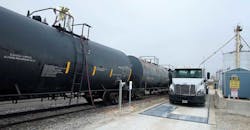Dangerous goods industry survey identifies global compliance issues
KEEPING up with regulations and ensuring compliance has become increasingly difficult for companies that handle and ship hazardous materials. That was a key finding in the annual 2018 Global Dangerous Goods Confidence Outlook conducted by Labelmaster, a leading provider of labels, packaging and technology for the safe and compliant transport of dangerous goods and hazardous materials.
Sponsored by Labelmaster, International Air Transport Association (IATA), and Hazardous Cargo Bulletin, the survey was conducted to gain insight into how organizations around the globe approach DG shipping and handling, and the challenges they face. Findings were presented at the 2018 Dangerous Goods Symposium in Rosemont, Illinois.
“Shipping dangerous goods is complex and high-risk, and those responsible for compliance have an increasingly critical job,” said Rob Finn, vice-president of marketing & product management, Labelmaster. “In an effort to better understand today’s dangerous goods landscape, Labelmaster, IATA and Hazardous Cargo Bulletin partnered to gather insights from DG professionals across the globe. We found that while many organizations have the necessary infrastructure, training and processes to ensure compliance across their supply chains, a large number do not.”
Key findings from the survey include:
Keeping up with regulations and ensuring compliance is challenging: Regulatory compliance is critical to an organization’s ability to maintain a smooth supply chain. Yet with growing volumes and types of dangerous goods, increasingly complex supply chains, and more extensive regulations, many industry professionals find it challenging to do their jobs effectively and efficiently.
In fact:
•51% find it challenging to keep up with the latest regulations.
•15% were not confident that they can ensure dangerous goods regulatory compliance across their entire organization, and 13% were unsure.
•58% feel that even if they follow the regulations perfectly there is a chance their shipments will be stopped.
When asked to rank their greatest challenge to compliance: budget constraints (28%); company leadership not aware of risk (21%); insufficient or ineffective training (19%); lack of technology (17%); difficulty in keeping up with changing regulations (15%).
Compliance technology and training are often inadequate. Those responsible for DG face an uphill battle--not only in meeting evolving regulations, but also in overcoming inadequate infrastructure and training. Technology is critical to the supply chain, and significantly improves efficiency, speed, accuracy and more. And even with technology resources available, 28% of dangerous goods professionals are still doing everything manually.
Furthermore, 15% believe their company’s infrastructure ability to quickly adapt to regulatory and supply chain changes is “lagging behind the industry,” 65% said it is “current, but need updating” and 21% believe it is “advanced--ahead of the industry.”
The need for improvement extends to training as well. One-quarter of respondents feel their company’s training does not adequately prepare people within the organization to comply with dangerous goods shipping regulations. In many cases, the scope of employees being trained needs to be expanded. In fact, 67 percent of respondents believe dangerous goods training should be extended to other departments across their company.
An organization’s attitude towards compliance impacts its level of investment: An organization’s attitude towards dangerous goods compliance has a direct impact on how much a company invests in compliance resources. Unfortunately, their attitude towards compliance often does not reflect its true value.
According to the survey:
•16% indicated that dangerous goods compliance is not a major priority for their company.
•54% wish their companies would understand that supply chain and dangerous goods shipping management could be a differentiator.
•27% think their company’s investment to support DG compliance is “not adequate to meet current needs.”
•28% believe their company complies “only because regulations mandate it, and adhere to minimum requirements,” while 48% believe their company “goes beyond requirements,” and 23% view compliance as a “competitive advantage.”
Hazardous materials professionals desire additional support: Investment in infrastructure and training is critical to enabling hazmat professionals to do their jobs effectively and efficiently, and whether their budgets have increased, decreased, or stayed the same, hazmat professionals desire additional support. When asked how they would prioritize financial support from their organization: more effective training (42%); technology for better supply chain efficiency and compliance (29%); wider access to the latest regulatory resources and manuals (18%); additional headcount (12%).
Finn added: “The risk associated with shipping and handling dangerous goods is greater than ever and industry professionals responsible for managing it need the proper technology, training, and regulatory access to ensure they are moving goods in a secure, safe, compliant, and efficient manner. Unfortunately, obtaining the necessary budget and resources likely requires buy-in from executive leadership, which can be an uphill battle. So how do you get that buy-in? It starts with changing the conversation around DG management.”
Changing the conversation means reframing the overall view of DG management within an organization. This begins with DG professionals quantitatively demonstrating how their compliance program can reduce costs and increase revenue to make a positive contribution to the company’s bottom line. Simply put, it is defining your company’s “total value of compliance,” which takes into account three factors:
The cost of maintaining compliance throughout the supply chain, such as expenses for people, compliance products, software & technology, reporting, training, etc.
The cost of non-compliance due to errors and lapses, such as penalties, carrier refusal and delays, fines, remediation, higher insurance costs, and other factors.
The opportunities of higher level compliance-enabling differentiation, revenue growth and faster cash flows, such as faster product deliveries, increased brand equity, the ability to offer a wider range of products, etc.
This Total Value of Compliance (TVC) framework helps DG companies make compliance a powerful, revenue-positive aspect of their business. To learn more about the total value of compliance, download a TVC technical brief and schedule a free assessment, visit www.labelmaster.com/tvc.
